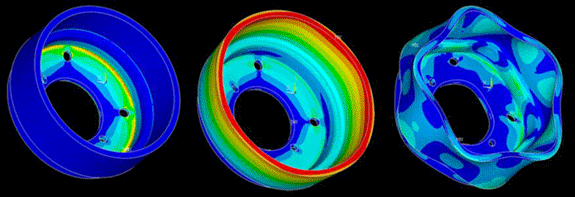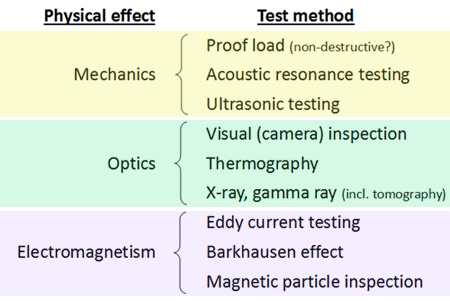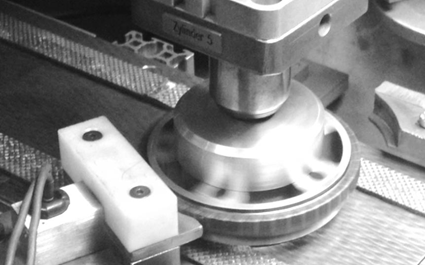2013 Hagen Symposium: Non-destructive testing in Powder Metallurgy manufacturing
The main focus of the 2013 Hagen Symposium was on quality and productivity in Powder Metallurgy. Dr Eberhard Ernst, GKN Sinter Metals Engineering GmbH, Germany, presented a comprehensive and systematic review of non-destructive test (NDT) methods used in the quality assurance of PM structural components.
NDT methods are based on physical effects
According to Ernst, all NDT methods are indirect tests based on physical effects which are related to defects in the parts. Mechanical, optical and electrical test methods are available for finding defects (Fig. 1).
All test methods listed in Fig. 1 provide information about certain parts of the test pieces such as the entire volume or local volumes, local surfaces, local surface layers, edges, transitions, notches, etc. They can be applied manually or, preferably, automatically and in line with the production process.
Typical defects in PM structural parts
Typical defects generated by the PM production process are powder contamination by foreign objects, local density variations, shear cracks and brittle fractures. Foreign objects can have sizes between 1/100 mm and several millimetres, depending on the sieves used prior to filling the powder mix into the die cavity. Either they burn off during sintering and leave hollow spaces or remain as foreign objects, often not firmly connected to the sintered matrix. Small contaminations or pores are uncritical since their effect is similar to the pores that the material contains anyway, but larger ones can reduce the strength, particularly for dynamic and alternating loading.

Fig. 2 Shear crack (left) and brittle crack in green PM compacts (courtesy GKN Sinter Metals Engineering)
Density variations in PM compacts may occur depending on the tool design and pressing action. They can lead to dimensional problems and should be eliminated prior to volume production. Then they are no longer subject of production-related NDT. Shear cracks are generated during compaction due to powder displacement inside the die cavity. These cracks are so-called “closed” cracks because the material integrity is interrupted without creating an air gap. Brittle fractures that may arise during ejection are usually closed cracks too, and sometimes open (Fig. 2). Only incorrect handling of green parts usually leads to open cracks. Ernst concluded that the defects of greatest interest are hollow spaces, possibly with internal foreign objects, and closed cracks. Further he stated that it is generally necessary to know the nature of possible defects and tune the NDT methods for the defect type and location.
Limits of non-destructive testing
The typical structure of a PM compact consisting of pressed or sintered metal powder particles and pores creates a basic noise signal in practically all NDT systems. A response signal of a defect must be so strong that it can be automatically distinguished from this noise. Consequently the smallest detectable defects must be bigger than the biggest structures of the compact. Ernst estimates the smallest detectable defect size in PM structural parts at 0.5 mm. He evaluated the various NDT test methods regarding their capabili-ties for powder metal compacts.
Mechanical methods
Applying a proof load whose magnitude is higher than the normal operational loading of the part and smaller than the designed maximum load is very easy to perform, but the risk to damage the part is high. Ernst presented examples where this method had catastrophically failed and did not recommend it.
Acoustic resonance testing is a test that affects the entire volume of a part by exciting resonance frequencies up to 80 kHz. It is fast and therefore suitable for in-line integration. The most relevant resonance frequencies must be recognised and evaluated. It has been observed that even very large cracks were not detected if the correlated resonance frequencies were not considered. Resonance frequencies can shift from lot to lot or even within a lot if the numbers of produced parts are very high. Fig. 3 shows a selection of vibrational modes which can be excited by knocking on a part.

Fig. 3 Possible calculated resonance shapes of a part show the affected areas red-yellow (courtesy GKN Sinter Metals Engineering)
Ultrasonic testing locally introduces a wave signal into the part and the reflected waves coming from all internal surfaces are registered. Ernst stated that defects in the entire volume can be detected with the exception of positions less than 1 mm below the surface and 2 mm below the ultrasonic probe. The orientation of defects must be so that the signal is reflected towards the sensor. If the limitations of ultrasonic testing are considered, it is reportedly a feasible method for inspecting PM compacts.
Optical methods
Visual defects at the surface of a compact, edges, profiles and transitions can be checked with optical cameras. Ernst reported that cracks can only be detected if the gap is at least a few hundredths of a millimetre, limiting optical camera inspection to only special cases.
Attempts at GKN to register variations of heat flow caused by defects with an infrared camera (thermography) were not satisfactory. Artificial defects and brittle fractures in green compacts could not be detected. Ultrasonic excitation of vibrations causing heat dissipation at crack tips of sintered parts required high energies and the ultrasonic frequency had to be suitable to find resonance at the position of the crack (Fig. 4).

Fig. 4 Infrared image of a PM part with ultrasonic excitation, left without crack, right with crack (courtesy EDEVIS)
According to Ernst, X-ray radiography can only detect defects if the absorption of the radiation is affected by at least 0.5% as compared to the surroundings. Cracks in green PM compacts are usually no volume defects and are therefore invisible for X-rays even if the orientation towards the source is favourable. While digital radiography is fast enough to be used for in-line inspection, computer tomography is so expensive and time consuming that it can only be applied for selected samples.
Electromagnetic effects
A widely used and well-established test method is eddy current testing. It can be applied as an integral test comparing the microstructures of components when parts are passed through a test solenoid or inspect critical details of a part with specially adapted probes. Typical defects that can be detected are more than 1 mm long and at least 0.5 mm below the surface. Internal cracks in a depth of more than 1 mm cannot be detected.
The Barkhausen Effect, i.e. the discontinuous magnetisation of ferromagnetic materials due to structural details, can be utilised in a similar way to eddy current testing to apply a comparative test of microstruc-tures, but defects are not detected. A gear rotating in front of a magnetic Barkhausen probe is shown in Fig. 5. It is integrated in a production line for 100% inspection of the gear toothing.
Impregnating parts in a magnetic field with a fluorescent liquid containing magnetic particles is known as the Magnaflux test. The magnetic particles are then concentrated at surface cracks which can be detected in UV light. This test has been in use for decades. Attempts were made at GKN for an automatic evaluation of the test in order to eliminate the uncertainties of human inspection. However, the costs were so high that the development was aborted.
In conclusion Ernst stated that non-destructive test methods are not always suitable for finding all possible defects, but they always lead to a better understanding of the manufacturing processes. After all, “quality is not achieved by testing, it is engineered,” he stated.
Author: Dr Georg Schlieper, Gammatec Engineering GmbH, Germany
Dr.-Ing. Georg Schlieper, physicist, received his PhD at the Insitute for Materials and Solid State Research of the University of Karlsruhe, Germany. He worked for 15 years in product and process development for the Powder Metallurgy industry where he focused on high strength sintered steels, heat treatment, surface technology, magnetic materials and metal injection moulding. Since 1994 he has worked independently as a consultant. Email: [email protected]
Download FREE PM Review magazine | News | Articles | Subscribe to e-newsletter







